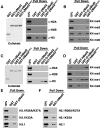Histone H3K4 methylation regulates deactivation of the spindle assembly checkpoint through direct binding of Mad2
- PMID: 27198228
- PMCID: PMC4888839
- DOI: 10.1101/gad.278887.116
Histone H3K4 methylation regulates deactivation of the spindle assembly checkpoint through direct binding of Mad2
Abstract
Histone H3 methylation on Lys4 (H3K4me) is associated with active gene transcription in all eukaryotes. In Saccharomyces cerevisiae, Set1 is the sole lysine methyltransferase required for mono-, di-, and trimethylation of this site. Although H3K4me3 is linked to gene expression, whether H3K4 methylation regulates other cellular processes, such as mitosis, is less clear. Here we show that both Set1 and H3K4 mutants display a benomyl resistance phenotype that requires components of the spindle assembly checkpoint (SAC), including Bub3 and Mad2. These proteins inhibit Cdc20, an activator of the anaphase-promoting complex/cyclosome (APC/C). Mutations in Cdc20 that block Mad2 interactions suppress the benomyl resistance of both set1 and H3K4 mutant cells. Furthermore, the HORMA domain in Mad2 directly binds H3, identifying a new histone H3 "reader" motif. Mad2 undergoes a conformational change important for execution of the SAC. We found that the closed (active) conformation of both yeast and human Mad2 is capable of binding methylated H3K4, but, in contrast, the open (inactive) Mad2 conformation limits interaction with methylated H3. Collectively, our data indicate that interactions between Mad2 and H3K4 regulate resolution of the SAC by limiting closed Mad2 availability for Cdc20 inhibition.
Keywords: H3K4; HORMA domain; Set1; chromatin; lysine methylation; spindle assembly checkpoint.
© 2016 Schibler et al.; Published by Cold Spring Harbor Laboratory Press.
Figures






References
-
- Aravind L, Koonin EV. 1998. The HORMA domain: a common structural denominator in mitotic checkpoints, chromosome synapsis and DNA repair. Trends Biochem Sci 23: 284–286. - PubMed
Publication types
MeSH terms
Substances
Grants and funding
LinkOut - more resources
Full Text Sources
Other Literature Sources
Molecular Biology Databases
Miscellaneous
